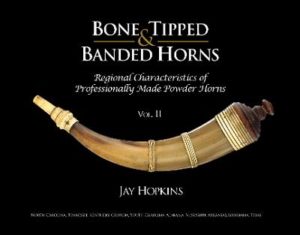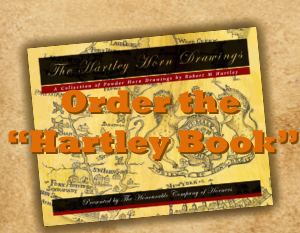A Most Ancient Art & Mystery
July 15, 2011 by Bill Carter
Filed under Articles from the Archives
The following article by Tom Ames was first published in the December 1996 issue of The Horn Book. You’ll find that a lot of Tom’s feelings, attitudes and beliefs mentioned in this article are also reflected in the segment “Part II – Judging Accouterments at Dixon’s” in the Winter 2011 issue of The Horn Book. This discussion of “the inner voice” and “our quest for understanding” the true meaning of our heritage through various artifacts is always of great interest.
Our thanks to Tom for allowing the reprint of this article on the Website.
-Bill Carter
A Most Ancient Art & Mystery
by Thomas E. Ames

Thomas Ames
Often the most rewarding experiences come when we least expect them: from unexpected finds in flea markets to an all too rare horn at a good price (for the buyer, that is) at a gun show. I call these “gifts of the spirit,” almost as if the one who had lived with the relic horn or gun reaches into our subconscious to prepare us for the discovery. A few of you may know the story behind how I came to find a spout stopper that seemed to have gone with a horn purchased on a bag half an hour earlier. The original stopper with a vent pick inserted in the shaft had been lost from the original outfit. Within the hour, some miles distant, a stopper complete with pick was found.
Coincidence? No, such events occur far too often for it to be chance. How many people know the story of how Madison Grant came to reintroduce the folding Barlow pattern knife and fork pictured in The Kentucky Rifle Hunting Pouch? [plate 128, page 197] Was this an original set? Perhaps, perhaps not. But each exemplifies the character of the other and by that compliment they encourage appreciation and our quest for understanding the lives of our forebears. Such is the value of the relics they’ve left behind for us. Listen and feel of what they tell us and listen to that inner voice as you recreate them.
Such is the value of the work we leave behind as contemporary artisans following in the footsteps of our ancestral heritage. At times even the plainer examples of our labor become masterpieces by virtue of their voice to our inner being. Sometimes they radiate their own specialness beyond even the critical eye of their maker.
Bob Chattin, a well known horner in southeastern Pennsylvania and a founding member of our Company, has been active for many years at Dixon’s Gun Fair. Early on, I chose to establish a working friendship with Bob and his partner, Jeff Renninger, because they were competent craftsmen in their own right. Both Bob and Jeff worked in a traditional manner and that was all important to me. They did not need my influence beyond the critique stage. They deserved the right to develop in their own way, their own unique style.
Well, things change over the years and we became more than passing acquaintances at the Gunmakers’ Fair each year. Yes, I wanted an example of the work they exhibited and quietly waited for that special piece that would encompass a regional feeling as well as fill a void for pouch service related to a particular gun.
I found that special piece at the rifle frolic on the Henry Factory site last June: a ringed or banded horn of fine architecture, painted red, shadowing an original regional production. It would serve to balance the refined architecture of the plain rifle of the region that I use in the field.
In July, Bob Chattin approached me as I arrived at the Gunmakers’ Fair at Dixon’s and handed me a small pocket horn. On it he had engraved a likeness of the regional liberty capped figure head. He asked me to critique the likeness.
Many of you know of my long research about this particular motif so I didn’t consider Bob’s request as anything more that an honest appraisal. The first thing to strike me, however, was the well polished honey colored maple base; semi-domed, it radiated a degree of depth that struck me as a very fine attribute to the entire package. It was like looking into a clear sun lit pool of water with each layer of grain reflecting its own light. I commented to Bob briefly on the whole horn and made note of the attraction of the base treatment.
Late on Sunday afternoon, Bob brought the horn to me again and noted that perhaps I’d not seen everything the first time. As I rolled the horn around, I was pleased and honored to see a newly made inscription: “To Thos Ames, a token of respect and friendship from Robt Chattin.”
On my way homeward from Dixon’s, I stopped for dinner with the Odle family. I related the story of Bob’s presentation and handed the horn to him. Mark was drawn to the base details as we sat across the dinner table. In the restaurant’s lighting, a face appeared to radiate from deep within the base plug!
There, in the maple, was the liberty capped figure head of Tammany appearing to stare from the natural holograph. Intentional? I think not! Each fiber of wood grain picked up by the artificial lighting in the restaurant could not belie the unintended spirit behind its maker. No creative hand could have represented the spirit of Tammany any better. It was dimensional, the face reflected in the holograph of creation. The dictionary defines holograph as “a document solely in the handwriting of its author.”
When I turn the base upside down, as with any two faced grotesque, another face appears to issue from its depths – that of a wizened old man. Eyes drawn, his face lined and creased with knowledge, his mouth hidden behind a drooping mustache. I have to ask myself: who is the author of such a document? Who are we to judge the true creative spirit of another? Why do we feel we must compare the merits of one against another? What value do we place on our special gifts, be it a contemporary horn with special meaning or a relic that somehow found its way to us in a manner that defies rational explanation? And finally – Bob, did you know?
I trust we all shall find our answers as we continue to express ourselves through creative spirit and the knowledge of the phrase that so endeared itself to the crafts of old as “the ancient arts and mysteries” will be made known unto you.




